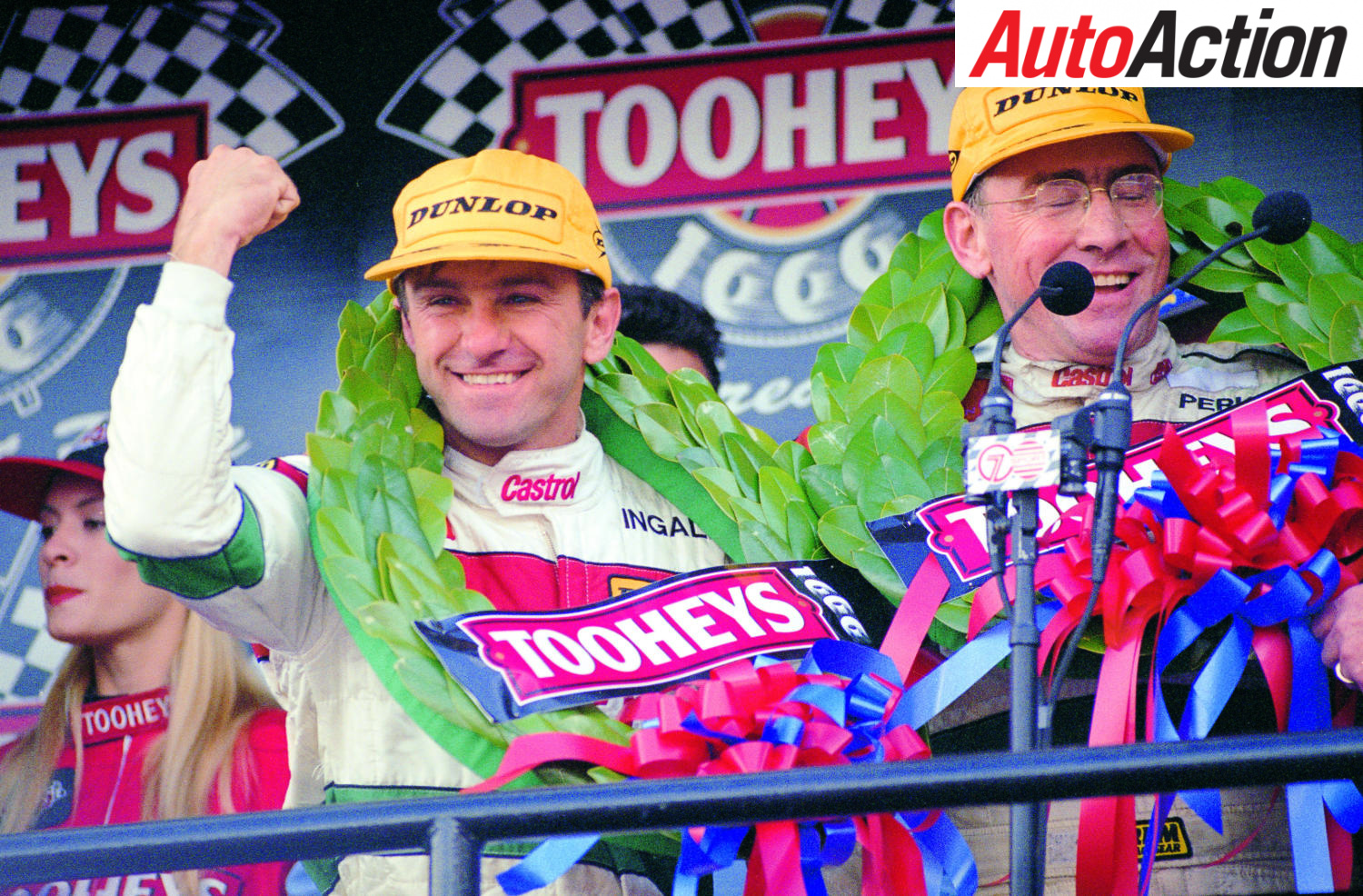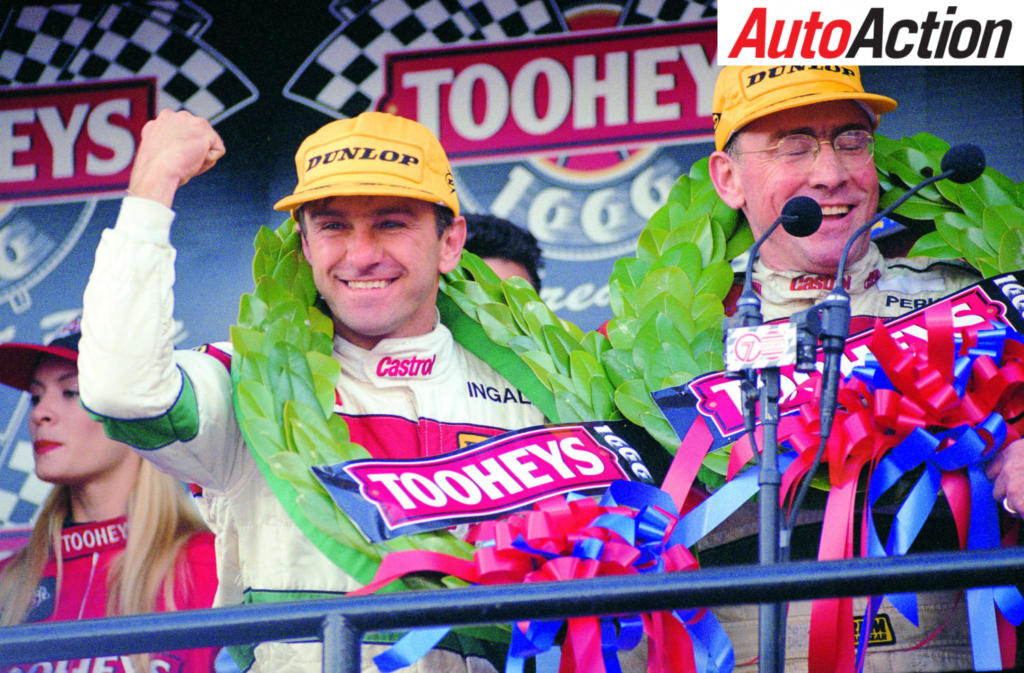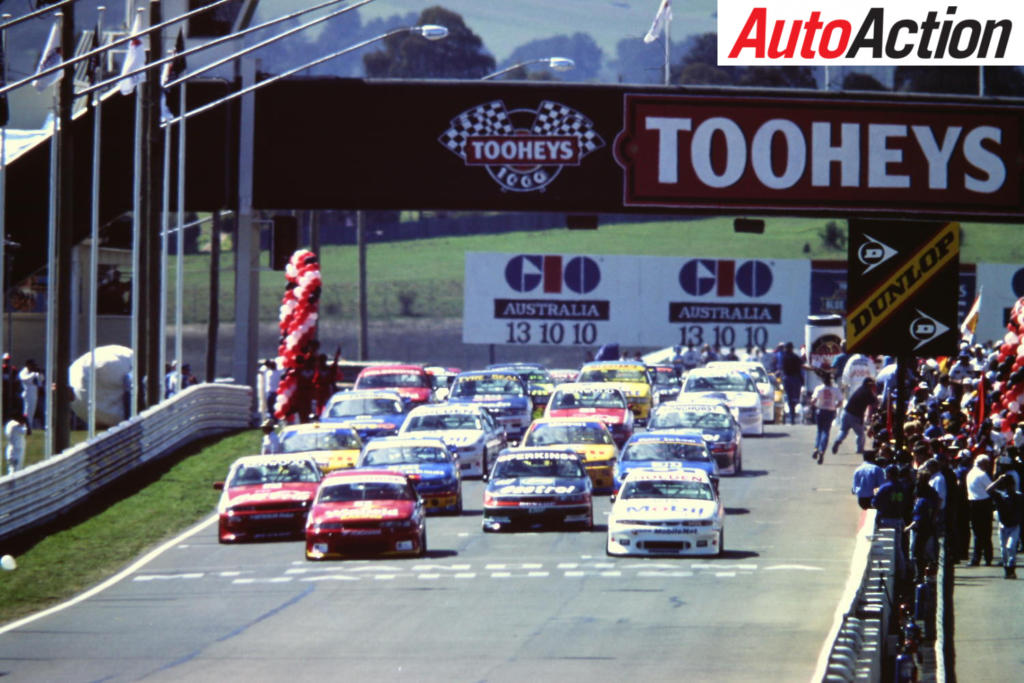LARRY PERKINS: BACK FROM THE BRINK


Larry Perkins: Back from the brink
Larry Perkins is well known as a former V8 Supercars driver and team owner and for winning the Bathurst 1000 six-times. Of the six wins Perkins claimed, none was more memorable than the 1995 come from behind victory.
By BOB WATSON
Before all his local success, the Holden fan favourite had humble beginnings growing up in the small north western Victorian township of Cownagie. Larry had witnessed his father Eddie win the 1956 ReDeX Round Australia Trial driving a Volkswagen in 1956, and this motivated him to follow his own dreams of a motor sport career. With all that followed, Perkins was later honoured with a sign outside the township.
He progressed from winning the 1971 Formula Ford ‘Driver to Europe’ Series to doing the same the next year in the Australian Formula 2 Championship, both in an Elfin 600.
He headed to Europe where he failed to qualify for the 1974 German Grand Prix in Chris Amon’s AF101, before dropping back to the European Formula 3 Championship the next season where he was successful and this returned the Aussie to the notice of the Formula 1 teams.
However, despite finishing a best of eighth driving an M175 Ensign-Cosworth for Boro in the 1976 Belgian Grand Prix, subsequent drives for Brabham, BRM and Surtees failed to bear fruit and Perkins returned home in 1977 to focus on a local touring car program that over time would grow into a substantial motorsport engineering business.
Driving with colourful motor sport personality, Peter Janson, and despite breaking his nose in a huge crash while racing in the Sandown 500, the Janson/Perkins combination finished a credible third in the 1977 Bathurst 1000 behind the famous Moffat/Bond one-two. During the successful relationship that followed, the pair finished second in both the 1979 and 1980 Bathurst 1000 races.

1979 was a particularly successful one for the ‘Cowangie Kid’, winning both the Rothmans International Series driving an Elfin MR8 and the Australian Rallycross Championship in his trusty VW beetle. Perkins then went onto to join the legendary Holden Dealer Team in what was a golden period for the team, as with Peter Brock he completed a hat-trick of victories from 1982-1984 including with John Harvey in 1983, the first-time three drivers greeted the flag first.
After leaving HDT in early 1985, Perkins started his own engineering firm which began the journey to his 1995 victory.
Outside of his touring car activities, he along with brother Garry built the Quiet Achiever solar car and was one of its drivers during its remarkable transcontinental solar crossing of Australia. In 1988 he also returned to Europe to race at the Le Mans 24 Hour with Tom Walkinshaw Racing, finishing fourth driving a Jaguar.
Perkins and his engineering company grew to encompass a customer program, but maintained success in his own cars, helping to establish the new Holden Racing Team program under Walkinshaw, and taking victory in the 1993 Bathurst 1000 partnered by motorbike convert Gregg Hansford.

The 1995 racing season started off tragically for Perkins as close mate Hansford lost his life in a Super Touring accident at Phillip Island. European ex-pat Russell Ingall then joined Perkins for the enduros and the pair finished a lap down in fifth on debut at Sandown.
Moving onto Perkins’ greatest triumph, the 1995 Tooheys 1000, he had clashed with Holden Racing Team Commodore pole sitter Craig Lowndes at the start, which caused a puncture, forcing him to fall from third to last on the first lap before pitting to replace the tyre.
“I had to resist the urge to drive to the pits as fast as I could,” said Perkins. “The flailing tyre could have taken off a guard or damaged the suspension, so it had to be slow and steady – very frustrating”
From stone motherless last, Perkins and co-driver Russell Ingall drove the car flat out for the entire race, gradually pegging back their massive deficit.
The charge was aided by attrition that affected their competition. Firstly, both Holden Racing Team Commodores had disastrous engine failures early in the race.
Next to fail was the Winfield Commodore shared by Jim Richards and Mark Skaife. The car had dominated the early running of the event and had superior fuel economy to its rivals, but a tailshaft broke on lap 65.

This was followed by both of Ford’s leading contenders colliding at Reid Park. Glenn Seton placed the nose of his Peter Jackson Falcon on the inside of John Bowe’s leading DJR Falcon, spinning the former into the wall and out of the race. It left an upset Bowe to plead his case to pit reporter Richard Hay.
“He must have thought it was a 10 lapper not 161 laps.”
Safety cars aided as well and the final one set up Perkins’ charge towards victory. He set about hauling in the second and third placed cars, first Alan Jones driving the second Peter Jackson Ford Falcon, then Brad Jones in the Coke Commodore.
The crowd at the top of The Mountain was almost hysterical as their hero then chased after the leader, Glenn Seton, in a race that he had dominated to that point.
“We benefitted from the misfortunes of others, particularly during the safety car periods, although it must be said most of the misfortunes were driver errors,” Perkins explained.
Perkins sat 7s behind Seton, slowly closing the gap and applying pressure to the Ford driver. Then going up The Mountain with 12 laps to go, Seton’s engine dropped a valve. Perkins moved by the stricken and now parked Falcon and went on to a dream victory.
“The fact that we were gaining on him made Seton use a few more revs, and that is when the engine blew,” Perkins said.
The lack of a pad change was also beneficial to the team, saving a significant amount of time in the pits. It was thanks to the engineering ingenuity of Perkins and his custom brake calipers which were designed in-house at Perkins Engineering in co-operation with Japanese brake pad supplier Endless (living up to its name). It was the first time in the Bathurst race that a car had gone the full distance without changing brake pads.
“The pit crew was magnificent. Each stop was a new record for them, everyone did their jobs perfectly,” Perkins said post-race.
It was a bitter disappointment for Seton. His Falcon engine had been built by the team’s chief engine builder and Glenn’s dad Barry (Bo) Seton. Seton bravely conducted an interview from the car on racecam while the race continued around him, as the cameras in the pits showed his father head in hands not wanting to believe the race was lost on what was the 30th anniversary of his win driving a Ford Cortina Mk I GT500.

After the race, Larry said, “After the first lap pit stop, every lap I drove was the fastest one I had done in my life. It was strange being at the tail of the field after the first pit stop, there were no other cars around me. At one stage I radioed to my pit and said ‘Is there anyone else in this race?’
Russell Ingall also played a significant part in the win, maintaining fast lap times while saving the brakes and was ultimately rewarded with a full-time Australian Touring Car Championship drive with Perkins for 1996.
“He [Ingall] was unbelievable – I’m sure Gregg would be happy with our replacement driver. A lot of people thought we had a weak link … but we couldn’t have won without his stints,” said Perkins about his new teammate.
“He did everything right. I hired Russell knowing what he could do but maybe he didn’t know if he could, because he hadn’t had to before.
“It was a fantastic feeling driving the final laps,” exclaimed Perkins. “During the season we had always raced the car in its Bathurst form, making no changes for other circuits. It was a well proven car, and it paid dividends”
Perkins also reminisced about Hansford, having conquered The Mountain with him two years prior.
“It makes me emotional to think about it,” Perkins reflected.
“Not many days go by when I haven’t thought of him, but I have to not to let it affect me, otherwise it would start everything crumbling.”
The Aussie battler, in a car he had engineered himself, had won the Great Race again and everyone loved it. It was a great moment in Australian motor sport.
The vast crowd went berserk after the win, flooding to the presentation area while a young Jack Perkins was in tears watching on television in the jubilant Castrol Perkins Racing pit garage.
A sign of the times was Perkins and Ingall drinking stubbies of Tooheys up on the rostrum after a hard day’s work.
When Perkins got back to Melbourne he was surprised to find quite a few slabs of beer on his doorstep. They had been sent by Ford fans who backed him at very long odds after the first lap pit stop!
Two years later, the duo repeated their victorious feat on The Mountain.
For Auto Action’s latest feature, pick up the current issue of the magazine, on sale now. Also make sure you follow us on social media Facebook, Twitter, Instagram or our weekly email newsletter for all the latest updates between issues.



